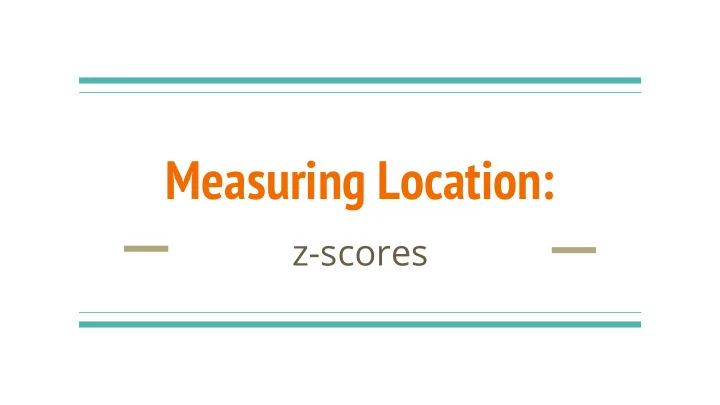

Measuring Location: z-scores
Example 1 Distribution of head circumference for male soldiers is approximately normal with mean = 22.8 inches and std. dev. 1.1 inches. a) What percent of soldier have head circumference greater than 23.9 inches? b) Between 21.7 and 23.9 inches? c) Less than 25.1 inches? UH OH…..what do we do now?????!?!?!?
Standardizing and Z-Scores ● All normal distributions are the same if we measure in units of size σ about the mean μ as center. ● Z-score: x is an observation that has μ and σ, so the standardized value is: x - mean z = standard deviation ● Always round the z-score to 2 decimal places!
Standardizing and Z-Scores ● The z-score tells us how many standard deviations the original observation falls away from the mean. ○ If x > μ, the z-score will be positive. ○ If x < μ, the z-score will be negative.
Example 1, continued... ● Distribution of head circumference for male soldiers is approximately normal with mean = 22.8 inches and std. dev. 1.1 inches. ● Find the z-score for head sizes less than 25.1 in x - mean z = standard deviation
Standard Normal Distribution ● N(0, 1) ● Find the area under any standard normal curve using Table A or the z- table.
Example 1, almost finished... Distribution of head circumference for male soldiers is approximately normal with mean = 22.8 inches and std. dev. 1.1 inches. The z-score for head size less than 25.1 in is 2.09. Using Table A find the probability of head sizes less than 25.1 inches.
Example 2 Women’s heights are normally distributed with μ = 64.5 inches and σ = 2.5 inches.
Example 2 ● What proportion of all young women are less than 68 inches tall? ● Find the z-score for height less than 68 in. x - mean z = standard deviation
Example 2, continued... Understand that the area under the N (64.5, 2.5) curve to the left of x = 68 is equal to the area to the left of z = 1.4 under the standard normal curve N(0, 1). Use Table A to find the percent of women that are less than 68 inches tall.
Remember! The z- value in Table A is the area/percentage to the left of the z-score.
Examples with Table A 1. Find the proportion of observations from the standard normal distribution that are less than 3.3 2. Find P (Z > -2.15) 3. Find the proportion of observations from the standard normal distribution that are between -2.15 and 1.4.
Examples with Table A 4. Find the proportion of observations from the standard normal distribution that are less than 2.2. 5. Find the proportion of observations from the standard normal distribution that are greater than -1.35. 6. P(-1.30 < Z < 2.65)
Standardizing and Z-Scores ● We can also use z-scores to compare the locations of individuals in different distributions.
FINDING NORMAL PROPORTIONS & FINDING A VALUE GIVEN A PROPORTION
Finding Normal Proportions 1. Standardize x to a standard normal variable z. 2. Draw a picture and shade the area of interest under the standard normal curve. 3. Find area using Table A and the fact that the total area under the curve is 1. 4. Write a conclusion in context of the problem.
Example 1 Height for women is N(64.5, 2.5). a. Find P (x< 68) b. Find P (x > 63) c. Find P (63 < x < 68)
Example 2 For 14-year old boys the distribution of blood cholesterol levels is normal with N(170, 30). a. What percent of 14 year old boys have more than 240 mg/dl of cholesterol? b. P (x ≤ 225) c. P( 170 ≤ x ≤ 240)
Example 3 Jessica took the SATs and the ACTs. On the SATs she got a 610. The SATs are normally distributed with a mean of 500 and standard deviation of 100. On the ACTs she got a 27. The ACTs are normally distributed with a mean of 18 and standard deviation of 6. On which test did she get a better score?
Finding a Z-Value Given a Proportion (aka Working Backwards with Table A) Example 4 Find the value z on the standard normal curve that is less than only the top 30% of the data.
Finding a Z-Value Given a Proportion (aka Working Backwards with Table A) Example 5 Find the value on the curve X = N(60, 2) that is greater than 20% of the population.
Recommend
More recommend